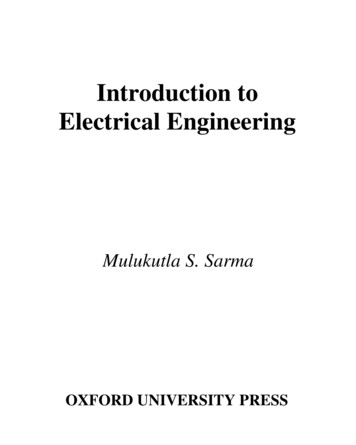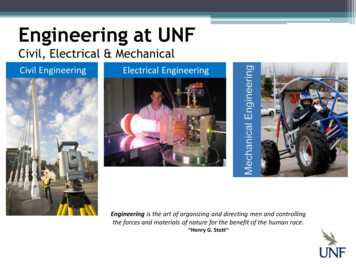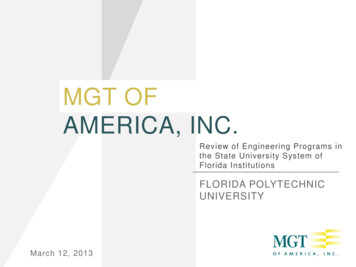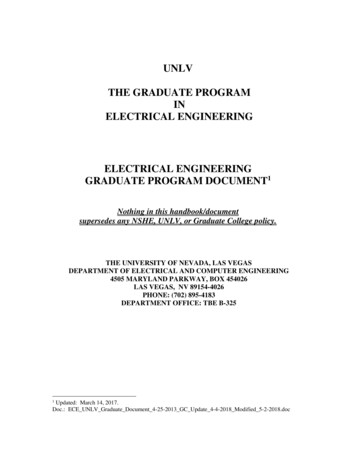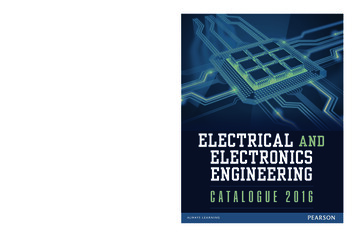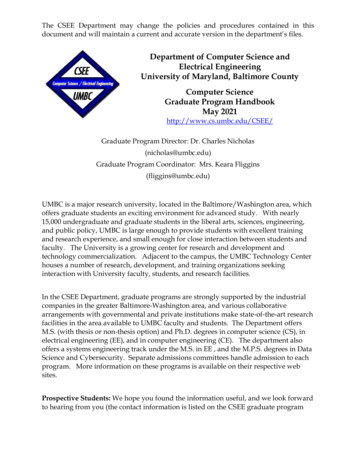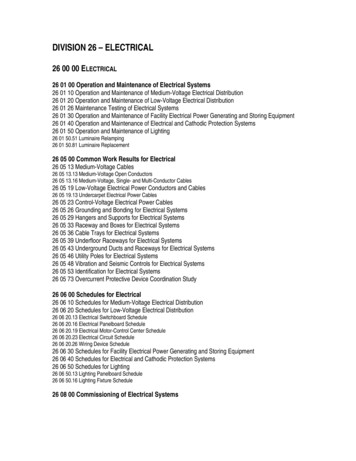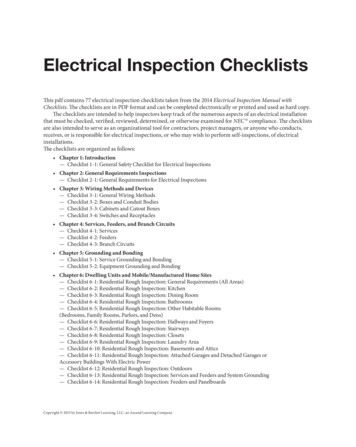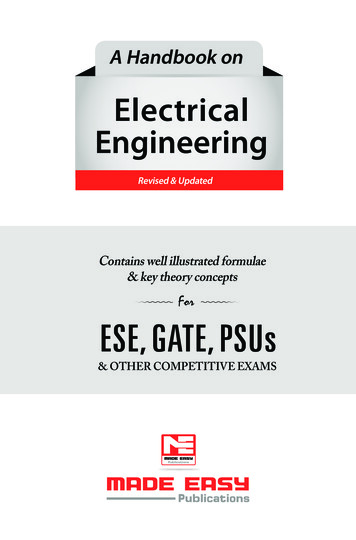
Transcription
A Handbook onElectricalEngineeringRevised & UpdatedContains well illustrated formulae& key theory conceptsForESE, GATE, PSUs& OTHER COMPETITIVE EXAMSPublications
PublicationsMADE EASY PublicationsCorporate Office: 44-A/4, Kalu Sarai (Near Hauz Khas Metro Station), New Delhi-110016Contact: 011-45124660, 8860378007E-mail: infomep@madeeasy.inVisit us at: www.madeeasypublications.orgA Handbook on Electrical Engineering Copyright, by MADE EASY Publications.All rights are reserved. No part of this publication may be reproduced, stored in or introduced into aretrieval system, or transmitted in any form or by any means (electronic, mechanical, photo-copying,recording or otherwise), without the prior written permission of the above mentioned publisher ofthis book.First Edition: 2012Second Edition: 2014Third Edition: 2015Fourth Edition: 2019Typeset at: MADE EASY Publications, New Delhi-110016
Director’s MessageDuring the current age of international competition inScience and Technology, the Indian participation throughskilled technical professionals have been challenging to theworld. Constant efforts and desire to achieve top positionsare still required.B. Singh (Ex. IES)I feel every candidate has ability to succeed but competitiveenvironment and quality guidance is required to achievehigh level goals. At MADE EASY, we help you to discover your hidden talentand success quotient to achieve your ultimate goals. In my opinion CSE, ESE,GATE & PSUs exams are tool to enter in to main stream of Nation serving. Thereal application of knowledge and talent starts, after you enter in to the workingsystem. Here in MADE EASY you are also trained to become winner in your lifeand achieve job satisfaction.MADE EASY alumni have shared their winning stories of success and expressedtheir gratitude towards quality guidance of MADE EASY. Our students have notonly secured All India First Ranks in ESE, GATE and PSUs entrance examinationsbut also secured top positions in their career profiles. Now, I invite you tobecome alumni of MADE EASY to explore and achieve ultimate goal of your life.I promise to provide you quality guidance with competitive environment whichis far advanced and ahead than the reach of other institutions. You will get theguidance, support and inspiration that you need to reach the peak of your career.I have true desire to serve Society and Nation by way of making easy path ofthe education for the people of India.After a long experience of teaching in Electrical Engineering over the period oftime MADE EASY team realised that there is a need of good Handbook whichcan provide the crux of Electrical Engineering in a concise form to the studentto brush up the formulae and important concepts required for ESE, GATE, PSUsand other competitive examinations. This handbook contains all the formulaeand important theoretical aspects of Electrical Engineering. It provides muchneeded revision aid and study guidance before examinations.B. Singh (Ex. IES)CMD, MADE EASY Group
CONTENTSA Handbook on Electrical EngineeringChapter 1 :V.Power Systems. 1-52VI. Choppers. 144I.Supply System. 1VII. Inverters. 150II.Line Parameters. 4VIII. AC Voltage Controllers. 159III. Performance of Transmission Line.14IX. Electric Drives. 162IV. Concept of Corona.23V.Mechanical Design of Overhead Lines.25VI. Balanced and Unbalanced Faults.27VII. Power System Stability.32VIII. Power System Transients.36Chapter 4 :Measurements andInstrumentation. 165-214I.Underground cable.40Characteristics of Instruments andMeasurement Systems.165IX. Economic Load Dispatch.38X.Phase Controlled Rectifiers. 129II.Circuit Components (Resistors,XI. Protective Relays.45Inductors, Capacitors).171XII. Circuit Breakers.48III. Galvanometers.173XIII. Generating Power Stations.50IV. Analog Meters.175XIV. Loads and Load Curves.52V.Chapter 2 :Electrical Machines. 53-101I.Transformers. 53II.Electromagnetic System. 66III. Basic Concepts in RotatingElectrical Machines. 68IV. D.C. Machines. 70V.Polyphase Induction Motors. 78VI. Polyphase Synchronous Machines. 89Chapter 3 :Power Electronics. 102-164I.Power Electronics. 102II.Thyristor. 108III. Diode Circuits and Rectifiers. 116IV. Thyristor Commutation Techniques. 124Instrument Transformers.183VI. Measurement of Power andWattmeters.186VII. Measurement of Resistance.191VIII. A.C. Bridges.197IX. Magnetic Measurements.204X.Electronic Instruments.205XI. Cathode Ray Oscilloscope.207XII. High Frequency Measurements.211XIII. Transducers.212Chapter 5 :Network Theory. 215-244I.Circuit Elements andSignal Waveform.215II.Network Laws and Theorems.222III. Graph Theory .227
IV. Laplace Transform Analysis andVII. Metal Oxide Semiconductor FieldCircuit Transients.230Effect Transistor.344Resonance.234VIII. Transistor Hybrid Model.347VI. Magnetically Coupled Circuit.236IX. Feedback Amplifiers.350VII. Two Port Network.238X.VIII. Network Synthesis.241XI. Large Signal Amplifiers.360IX. Dual Network.244XII. The Signal Generators andV.Operational Amplifiers.354Wave Shaping Circuits.366Chapter 6 :Control Systems. 245-282Chapter 9 :I.Introduction.245Digital Electronics. 373-418II.Mathematical Modelling.246I.Number System and Codes.373III. Transfer function.253II.Logic Gates.376IV. Time Response Analysis ofIII. Boolean Algebra andV.Control System.258Reduction Techniques.383Stability in Time-Domain.265IV. Digital Logic Circuits.388VI. Industrial Controller.269V.VII. Compensator.272VI. Registers.400VIII. Frequency Response Analysis.273VII. Counters.402IX.VIII. Digital ICs Family.406State Space Analysis.281Chapter 7 :Sequential Circuits.395IX. DACs and ADCs.412Signals and Systems. 283-307Chapter 10 :I.Electrical Materials. 419-448Introduction to Signals.283II. Linear Time Invariant Systems.290I.III. Fourier Series.292Dielectric Properties ofInsulating Materials.419IV. Fourier Transform.296II.V. Laplace Transform.298III. Magnetic Properties of Materials.430VI. Z -Transform.303IV. Conductive Materials.436Chapter 8 :Analog Electronics. 308-372I.Semiconductor Physics.308II.Junction Diode Characteristics.317V.Dielectric Breakdown.427Semiconductor Materials.441VI. Insulating Materials.443VII. Crystal Structure.446Chapter 11 :III. Bipolar Junction Transistors.327Electromagnetic Theory. 449-487IV. Transistor Biasing Circuits.333I.Vector Calculus.449V.II.Coordinate systemBJT as an Amplifier.336VI. Junction Field Effect Transistors.339and Transformation.450
III. Electrostatics.459IV. Interrupts.513IV. Magnetostatic Field.468V.V.Maxwell’s Equations.473VI. Introduction to 8086.518VI. Electromagnetic Wave Propagation.476VII. Microcontroller.524VII. Incidence of EM Wave.481VIII. Transmission Lines.484Interfacing with Microprocessor.515Chapter 13 :Communication Systems. 533-556Chapter 12 :I.Basics.533Microprocessors. 488-532II.Fourier Series, Energy and Signals.535I.Introduction.488III. Analog Modulation.536II.Architecture of 8085.489IV. Pulse Modulation.545III. Instruction Set and Data Formats.496V.Digital Carrier Modulation.550VI. Random Variables and Noise.553nnnn
After a long experience of teaching in Electrical Engineering over the period of time MADE EASY team realised that there is a need of good Handbook which can provide the crux of Electrical Engineering in a concise form to the student to brush up the formulae and important concepts require


